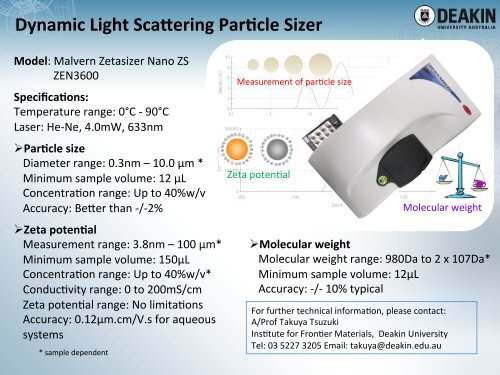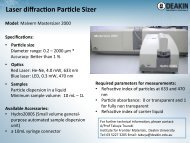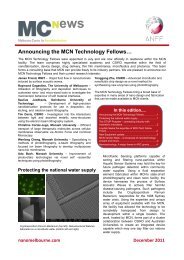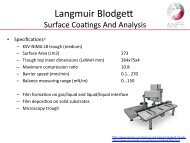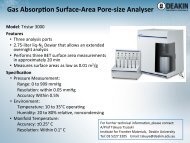Malvern Zetasizer Nano ZS ZEN3600 Dynamic Light Scattering ...
Malvern Zetasizer Nano ZS ZEN3600 Dynamic Light Scattering ...
Malvern Zetasizer Nano ZS ZEN3600 Dynamic Light Scattering ...
You also want an ePaper? Increase the reach of your titles
YUMPU automatically turns print PDFs into web optimized ePapers that Google loves.
<strong>Dynamic</strong> <strong>Light</strong> Sca.ering Par2cle Sizer Model: <strong>Malvern</strong> <strong>Zetasizer</strong> <strong>Nano</strong> <strong>ZS</strong> <strong>ZEN3600</strong> Specifica2ons: Temperature range: 0°C -‐ 90°C Laser: He-‐Ne, 4.0mW, 633nm Ø Par2cle size Diameter range: 0.3nm – 10.0 µm * Minimum sample volume: 12 µL ConcentraLon range: Up to 40%w/v* Accuracy: BeTer than -‐/-‐2% Ø Zeta poten2al Measurement range: 3.8nm – 100 µm* Minimum sample volume: 150µL ConcentraLon range: Up to 40%w/v* ConducLvity range: 0 to 200mS/cm Zeta potenLal range: No limitaLons Accuracy: 0.12µm.cm/V.s for aqueous systems * sample dependent Measurement of parLcle size Zeta potenLal Molecular weight Molecular weight Ø Molecular weight Molecular weight range: 980Da to 2 x 107Da* Minimum sample volume: 12μL Accuracy: -‐/-‐ 10% typical For further technical informaLon, please contact: A/Prof Takuya Tsuzuki InsLtute for FronLer Materials, Deakin University Tel: 03 5227 3205 Email: takuya@deakin.edu.au
Measurement Principles Par2cle size Molecular weight destrucLve interference construcLve interference Zeta poten2al
Opera2on Principle Digital signal processor Correlator Computer ATenuator Detector Laser Detector 90 o Cell Par2cle size measurement Combining opLcs Detector Beam spliTer ATenuator ScaTering beam CompensaLon opLcs Cell Digital signal processor Laser Zeta poten2al measurement Computer
Applica2on note: InvesLgaLon into the locaLon of dopant ions in semiconductor nanoparLcles Ø <strong>Zetasizer</strong> <strong>Nano</strong> <strong>ZS</strong> was used to invesLgate the zeta potenLal of ZnO nanoparLcles doped with Mn and Co. Ø The zeta potenLal of 5 at% Co-‐doped ZnO was nearly idenLcal with the value of undoped ZnO, indicaLng that Co did not precipitated out on the parLcle surface as a separate phase. Ø On the other hand, the zeta potenLal of 5 at% Mn-‐doped ZnO was lower than that of undoped ZnO, affected by the negaLve charge from Mn oxides that are precipitated on the parLcle surface.


